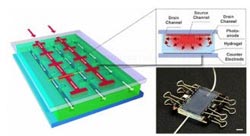Self-Healing Solar Cells ‘Channel’ Natural Processes

Dr. Orlin Velev, NC State University<br><br>NC State’s regenerative solar cell mimics nature by using microfluidic channels.<br>
The “branching” vascular channels that circulate life-sustaining nutrients throughout leaves and hands serve as the inspiration for solar cells that can restore themselves efficiently and inexpensively.
In a new paper, North Carolina State University researchers Orlin Velev and Hyung-Jun Koo show that creating solar cell devices with channels that mimic organic vascular systems can effectively reinvigorate solar cells whose performance deteriorates due to degradation by the sun’s ultraviolet rays. Solar cells that are based on organic systems hold the potential to be less expensive and more environmentally friendly than silicon-based solar cells, the current industry standard.
The nature-mimicking devices are a type of dye-sensitized solar cells (DSSCs), composed of a water-based gel core, electrodes, and inexpensive, light-sensitive, organic dye molecules that capture light and generate electric current. However, the dye molecules that get “excited” by the sun’s rays to produce electricity eventually degrade and lose efficiency, Velev says, and thus need to be replenished to reboot the device’s effectiveness in harnessing the power of the sun.
“Organic material in DSSCs tends to degrade, so we looked to nature to solve the problem,” Velev said. “We considered how the branched network in a leaf maintains water and nutrient levels throughout the leaf. Our microchannel solar cell design works in a similar way. Photovoltaic cells rendered ineffective by high intensities of ultraviolet rays were regenerated by pumping fresh dye into the channels while cycling the exhausted dye out of the cell. This process restores the device’s effectiveness in producing electricity over multiple cycles.”
Velev, Invista Professor of Chemical and Biomolecular Engineering at NC State and the lead author of a paper in Scientific Reports describing the research, adds that the new gel-microfluidic cell design was tested against other designs, and that branched channel networks similar to the ones found in nature worked most effectively.
Study co-author Dr. Hyung-Jun Koo is a former NC State Ph.D. student who is now a postdoctoral researcher at the University of Illinois. The study was funded by the National Science Foundation and the U.S. Department of Energy.
Note to editors: The abstract of the paper follows.
“Regenerable Photovoltaic Devices with a Hydrogel-Embedded Microvascular Network”
Authors: Hyung-Jun Koo and Orlin D. Velev, NC State University
Published: Aug. 5, 2013, in Scientific Reports
DOI: 10.1038/srep02357
Abstract: Light-driven degradation of photoactive molecules could be one of the major obstacles to stable long term operation of organic dye-based solar light harvesting devices. One solution to this problem may be mimicking the regeneration functionality of a plant leaf. We report an organic dye photovoltaic system that has been endowed with such microfluidic regeneration functionality. A hydrogel medium with embedded channels allows rapid and uniform supply of photoactive reagents by a convection-diffusion mechanism. A washing-activation cycle enables reliable replacement of the organic component in a dye-sensitized photovoltaic system. Repetitive restoration of photovoltaic performance after intensive device degradation is demonstrated.
Dr. Orlin Velev, 919/513-4318 or odvelev@ncsu.edu
Mick Kulikowski, News Services, 919/515-8387 or mick_kulikowski@ncsu.edu
Media Contact
More Information:
http://www.ncsu.eduAll latest news from the category: Power and Electrical Engineering
This topic covers issues related to energy generation, conversion, transportation and consumption and how the industry is addressing the challenge of energy efficiency in general.
innovations-report provides in-depth and informative reports and articles on subjects ranging from wind energy, fuel cell technology, solar energy, geothermal energy, petroleum, gas, nuclear engineering, alternative energy and energy efficiency to fusion, hydrogen and superconductor technologies.
Newest articles

Bringing bio-inspired robots to life
Nebraska researcher Eric Markvicka gets NSF CAREER Award to pursue manufacture of novel materials for soft robotics and stretchable electronics. Engineers are increasingly eager to develop robots that mimic the…

Bella moths use poison to attract mates
Scientists are closer to finding out how. Pyrrolizidine alkaloids are as bitter and toxic as they are hard to pronounce. They’re produced by several different types of plants and are…

AI tool creates ‘synthetic’ images of cells
…for enhanced microscopy analysis. Observing individual cells through microscopes can reveal a range of important cell biological phenomena that frequently play a role in human diseases, but the process of…





















